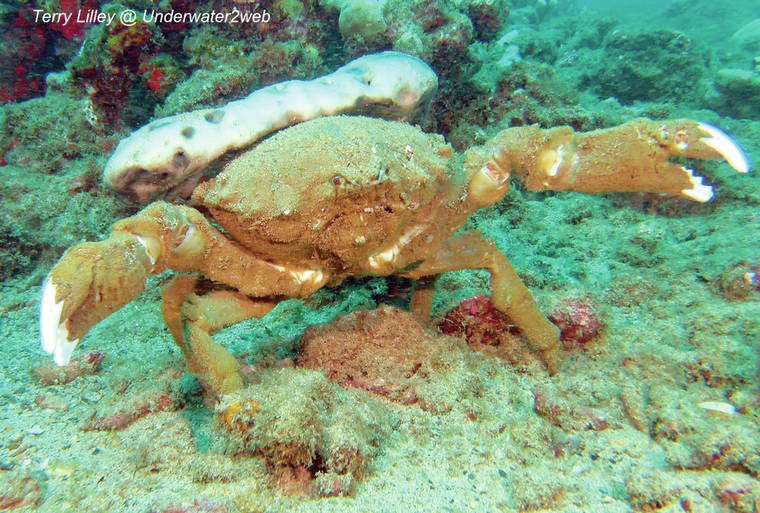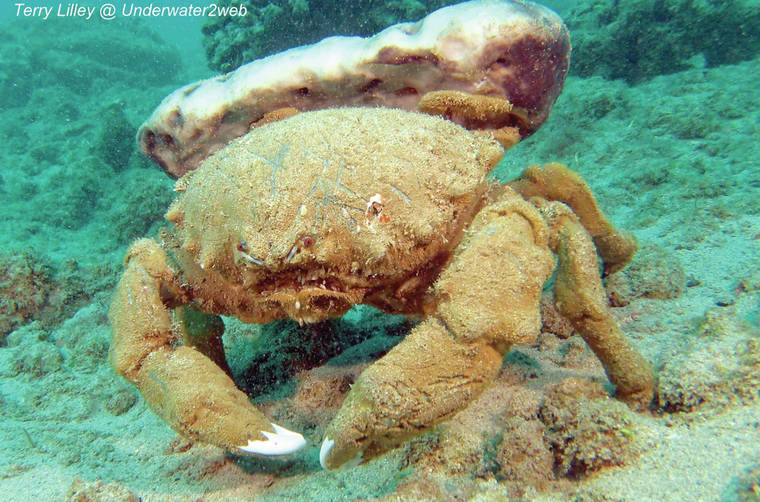The first time I saw a giant, foot-wide sleepy sponge crab while scuba diving, I had no idea what I was looking at. I was just shooting video of a white sponge growing on top of a brown rock back in a dark cave and, all of a sudden, the rock stood up and slowly walked away! Turns out it was not a rock but a huge, round crab covered in brown fuzz with a live sponge on its back and huge, white-tipped pincers.
The first time I saw a giant, foot-wide sleepy sponge crab while scuba diving, I had no idea what I was looking at. I was just shooting video of a white sponge growing on top of a brown rock back in a dark cave and, all of a sudden, the rock stood up and slowly walked away! Turns out it was not a rock but a huge, round crab covered in brown fuzz with a live sponge on its back and huge, white-tipped pincers.
Just recently I was diving in murky water after a rain and one of these slow-moving crabs came walking out of the gloom right at me, carrying its sponge on its back, and attacked the camera with its giant pinchers! I have dove with thousands of big sharks my whole life and I have never been attacked even once by them, but now I get attacked by a giant, grumpy crab carrying a sponge on its back! The whole thing could of been a scene out of a “Star Wars” movie set on some remote planet with strange creatures attacking the visiting humans.
Makua-o-ka-lipoa is not a normal crab! It has four tiny feet that grow out of the lower part of its back, and these feet hold onto a live sponge for camouflage. The crab looks just like a mud-covered rock, and moves very slowly across the reef, feeding on algae.
In Hawai‘i we do not have a lot of sponge growth due to our large surf, so sometimes the sponge crabs do not have sponges to put on their head, so they will grab just about anything they can hold onto that is the right size.
I have video of one with half of a coconut on its head, and some other divers have reported seeing them with slippers on their back, pieces of metal, and in one case someone’s wallet on the crab’s back!
As far as I know, its Hawaiian name refers to being sleepy, and this large crab is not edible and may actually be poisonous. I am surge large sharks will eat them, but the sharks don’t want to eat the poisonous sponge the crab is carrying on its back, so the crab may survive because it evolved to carry around its own armor.
You can see makua-o-ka-lipoa in action up on the educational web page at underwater2web.com, plus see a video of this sponge crab up on my Facebook just under my name.
The sponge crab will also be one of the critters in my new, upcoming movie, called “The Marine Life at Koloa Landing Kaua‘i” that will be out soon.
•••
Terry Lilley is a marine biologist living in Hanalei. He d co-founder of Reef Guardians Hawai‘i, a nonprofit on a mission to provide education and resources to protect the coral reef. To donate to Reef Guardians Hawai‘i, go to reefguardianshawaii.org.



